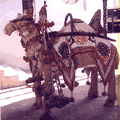
Kala Raksha Folk Art Museum

Kala Raksha Folk Art Museum
Sumrasar Sheikh, Bhuj, Kutch, Gujarat
India 370 001
In India it is said that language changes every 10 miles. So, too, regional styles of traditional embroideries. Through out the subcontinent’s embroidery belt there is extraordinary variety, which serves to express the identity of these communities. Some styles are regional, shared by several people living symbiotically in a region. Others are ethnic, expressing distinct identities of more isolated peoples.
Kala Raksha’s collections focuses on four of these styles: suf, khaarek, paako practised by peoples living in sub regions of the greater Thar Parkar region spanning Sindh, Rajasthan and Kutch and the ethnic style of Rabari pastoral nomads.
THE EXHIBITS
The exhibition hall presents suf, khaarek and Rabari styles in their cultural context. Old examples of Rabari work are plentiful. Suf and khaarek pieces are more rare. The Rabari textiles on display are original. The suf and khaarek embroideries are replicas from our collections made in 1998 by Kala Raksha artisans.
THE CULTURAL CONTEXT: THE TRADITIONAL ROLE OF EMBROIDERIES
Although suf and khaarek embroideries were generally settled and Rabari embroideries nomadic, the role of embroideries among these peoples was markedly similar.
The museum explores the traditional role of embroideries. In the village of the Thar Parkar and Kutch regions many embroideries were associated with pre marriage conventions. Girls were required to produce a set of embroidered items specifies by the community, to be exchanged with future in-laws at the several prescribed ceremonies of the marriage.
Today, with changes in lifestyle requirements have changed. Nonetheless, the embroideries required are still necessary before the ceremony can take place. In traditional societies, in which a bride is not seen until after the marriage, embroidered pieces sent after engagement introduce the bride to her husband and in-laws. The precious embroideries inform the family of her skill and care.
The text begins with the context of embroideries throughout the subcontinent, and the concept of traditional roles of embroidery in the Maru Meghwal community as a medium of exchange and celebration for wedding.
In the Rabari community the social function of producing embroidery is explored. Presenting embroideries exchanged by Rabaris, and those used in a wedding, leading to an examination of style. The panels encourage interaction by suggesting that the visitor search for motifs.
Two stands of jewelry introduce the concept of cohesive aesthetic in a community style. Outside, two displays enable the viewer to try some traditional stitches. The museum compares variations over region and time and explains various embroidery techniques.
In this small space Kala Raksha presents an introduction to traditional embroidery and a link between the collections and the artisans.
BIBLIOGRAPHY
– Article by Judy Frater, Kala Raksha: Artisan’s Oasis published in Span Magazine June 2000
– Brochure of Kala Raksha, Folk Art Museum – A thousand dialects in stitches.